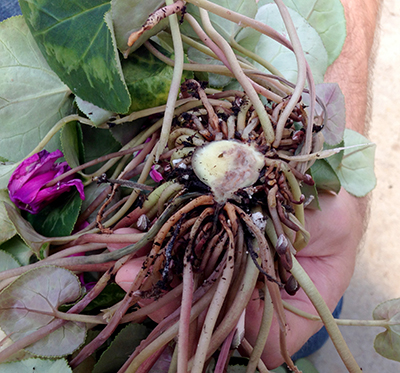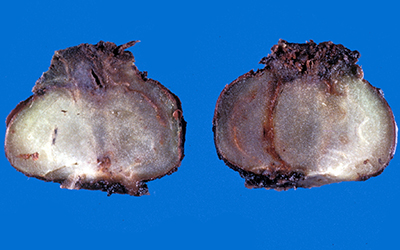Fusarium wilt of Cyclamen
When scouting your cyclamen crop, know the symptoms of the vascular wilt, Fusarium.

Fusarium wilt is a vascular wilt and a common pathogen of cyclamen. It is caused by Fusarium oxysporum f. sp. Cyclaminis, which infects the roots and moves through the plant’s xylem. Michigan State University Extension reminds you to please take note that the form of the Fusarium is very host-specific and in this case only infects cyclamen. There are also different races of the fungi, which may affect certain cultivars of cyclamen more than others.
Very warm temperatures of 75 to 95 degrees Fahrenheit and overly wet growing media provides suitable conditions for the inoculation of Fusarium. Plants may be asymptomatic until enduring an environmental stress such as drought. Plants exhibit symptoms more rapidly at temperatures above 70 F. The first symptom of Fusarium is the yellowing and wilting of the foliage. Initially, it is possible for symptoms to develop on only part of a plant or even part of a leaf. As the disease progresses, the foliage becomes brown and necrotic (Photo 1).
If you find a plant with chlorosis, necrosis, wilting or dieback, first remove the plant from the pot to look at the roots. Also, cut the plant along the base to look at the stem for discoloration (Photo 2). If discoloration is present, discard the plant and those close to it that are exhibiting symptoms to prevent further spread in the greenhouse, especially if using overhead irrigation or flood floors.

Photo 2. Fusarium f. sp. cyclaminis wilt on cyclamen. Photo credit: Heidi Wollaeger, MSU Extension
Similarly, discoloration is also present on infected corms prior to planting (Photo 3). When receiving new corms for propagation, be sure to examine them for Fusarium and other fungal and bacterial diseases.

Photo 3. Inspect incoming corms for Fusarium. Photo credit: Department of Plant Pathology Archive, North Carolina State University, Bugwood.org
Since a variety of vascular wilts and root rots often exhibit similar symptoms, be sure to get an accurate diagnosis. There is no currently available on-site testing kit for the forms of Fusarium that affect greenhouse crops. Samples can be sent to a diagnostic lab such as MSU Diagnostic Services for an accurate diagnosis.
Growers should discard all infected corms or plants and apply a Fusarium-labeled preventative fungicides on all other cyclamen in the area. High rates of ammonium nitrogen or low calcium in the media are conducive for the disease. Consider switching to a fertilizer with nitrate nitrogen, but keep in mind your water quality and the growing requirements of other plants in the greenhouse. Add lime to the growing media to keep the pH above 6.0 to manage Fusarium in the crop. However, remember that cyclamen thrive at a maximum pH of 6.3 and an EC of 1.8.
For more information, check out the plant disease report “Fusarium Wilt and Corm Rot of Cyclamen” from Penn State or “Cyclamen-Fusarium Wilt” from the Pacific Northwest Plant Disease Management Handbook. For tips on growing cyclamen, take a look at the cyclamen production growing guide developed by Paul Thomas at the University of Georgia.



 Print
Print Email
Email



